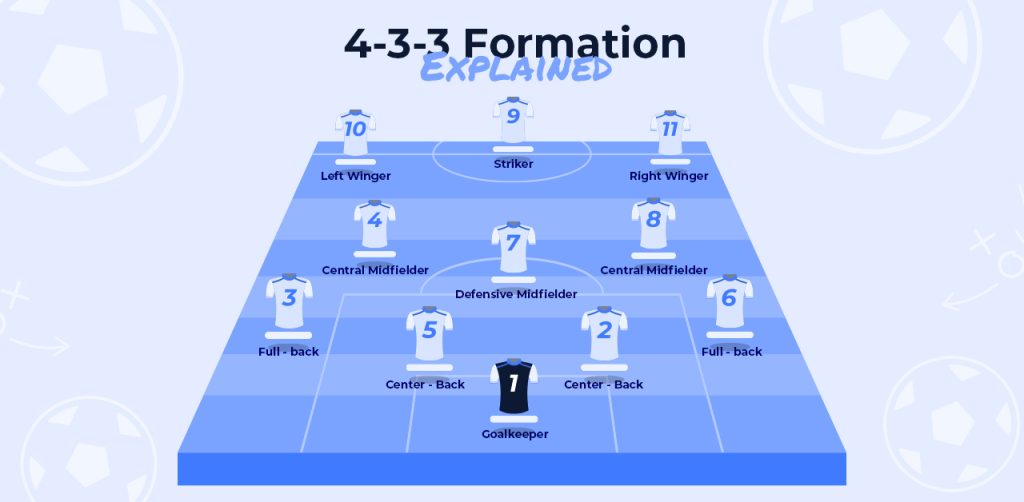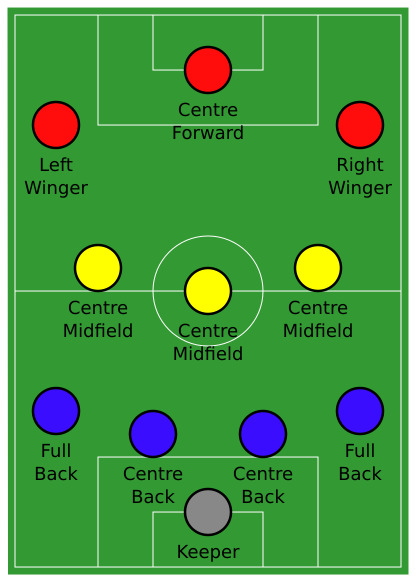Last Updated on January 18, 2024 by Mr. Betting

4 3 3 Formation How to Play – The Complete Guide
When it comes to football, there is no right or wrong tactic approach – each strategy has its own set of advantages and drawbacks. While some trainers may prefer to try a defensive approach by limiting the opposition’s chances, others may employ an aggressive pressing style looking to win the ball high up in the opponent’s half and create lots of chances.
The choice of formation is one of the most critical aspects of any tactical system. This article will explain why the 4-3-3 is so famous by giving you the best information to help you beat the 4-3-3. Keep reading and learn why this formation is so popular and what it looks like in action and why coaches opt for it.
What is the 4 3 3 Formation?
The soccer shape known as 4-3-3 is made up of three separate units or lines. At the front of the goalkeeper, it uses a traditional back four, which includes two central defenders and a left and right fullback. The midfield unit has three center midfielders who can lign up in various configurations and the three up front also have the ability to start an attack themselves if they win the ball back high up the pitch.
The most common shape is a midfield triangle, which features one central holding midfielder and two more advanced midfielders on either side of them. The central defensive midfielder may also be recognized as a classic number 6 or a single pivot.
The formation features an offensive trio in front of the midfielders. Usually, the lone striker (also known as the number 9) is followed by left and right wingers. Coaches can adjust the setup by playing inside-out wingers who work in the areas of the field close to the sticker.
They may also decide to play for a false nine who drops back into the midfield areas to help the team dominate possession of the ball. This shape is well-liked because of the coaches’ flexibility to adjust their midfield and from three (or even their defence).
Why is the 4 3 3 Formation So Popular?
The 4-3-3 soccer shape is well-liked among coaches because it provides flexibility, allowing them to adapt it both in and out of possession. Many coaches prefer to adjust the formation according to the skillset of their players and their preferred style of play.
In some cases, coaches choose to play their wingers high and wide, giving their team attacking expansion in the opponent’s half. While others prefer to play their wingers narrow and closer to the striker and rely on full-backs to provide width in attack.
How Do You Play the 4 3 3?

This formation has three main layers and is generally seen as an attacking formation. Safeguarding the goalkeeper are four defenders (including a right-back, two center-backs, and a left-back) positioned at the back. In front of them are three central midfield players who can be organized in many ways. Finally, the front 3 makes up the attacking force, which is usually made up of two wingers (or sometimes inside forwards) in addition to a central striker serving as the primary focus during the attacking stage.
That way, players can evenly cover the pitch while also ensuring the balance between defense, midfield, and attack. Remember that different coaches choose different strategies when organizing their players within the formation. The most common approach is to assign one of the three midfielders in the center to a defensive position as a holding modifier, providing additional support to the back four. A more offensive approach involves pushing one modifier forward to assist in the attack while the other two midfielders sit behind.
While the world of soccer formations keeps growing, one new variation of the 4-3-3 has become increasingly popular – the “false nine” approach, where the central forward drops back into a slightly extensive and more creative role, linking the midfield and attack. This 4-3-3 variation allows the wide players to cause more problems higher up the field and confuses opposition defenders by blurring the lines between midfield and attack.
What are the Strengths of the 4 3 3 Formation?
The 4-3-3 soccer formation has a key advantage in maintaining balance and strength across the field. The formation’s spine consists the two center-backs, three central midfielders, and a striker. This strong spine means a team can assert control in the field’s defensive, middle, and attacking thirds. Additionally, the full-backs and wingers on each side of the pitch ensure that the team can effectively attack and defend along the areas of the pitch.
This is the best formation for teams who want to dominate possession and build out the attack. It helps players to form triangles and diamonds naturally among the three sections of defense, midfield, and attack. These shapes provide various passing options to the player on the ball, such as short and easy passes to help the team.
By deploying three central midfielders, teams can gain a tactical advantage by outnumbering or matching their opponents in the vital areas in the center of the field. Introducing a false nine can further enhance this advantage, as it enables the team to control the tempo of the game and create numeral overloads.
The 4-3-3 is a very attacking formation. It is known for its strong emphasis on offense, making it a powerful tactical choice. Whether the coach instructs the full-backs to push forward or relies on two central midfielders to link with the front 3, a team utilizing this shape will typically create a daunting attacking force of 5 players, which can pose a challenge for even the most skilled and well-coordinated defenses.
The formation is one of the most effective in terms of defense, particularly for those teams who want to press high up the field. This popular formation allows the three forwards to work as a collective unit by putting pressure on the ball and offering coverage and support whenever necessary. Consequently, if the team succeeds in recovering the ball at a high position, the chances of creating scoring opportunities are significantly higher.
Weaknesses of the 4 3 3 Formation
The 4-3-3 shape may cause some teams to have a weak defense, especially when their full-backs push up high. This vulnerability becomes more evident when the opposing team counters. It can be dangerous if the team is playing with a high defensive line. An example is when Aston Villa secured a remarkable 7-2 victory against Liverpool in the 2020-21 season.
For the 4-3-3 formation to work effectively, it is crucial to possess highly specialized players for each position who know their exact roles and can carry them. Otherwise, there may be vulnerable areas on the field that the opposing team can take advantage of. To be effective, the 4-3-3 formation must have very high stamina. That means all players should be able to press opositions into makes. That’s necessary because the formation relies heavily on players constantly pressuring the opponent. If this pressure is not adequately maintained, it may result in unoccupied areas on the field that the other team could exploit.
Which Clubs and Managers Use the 4 3 3 Formation in Soccer?
Many teams have successfully used the 4-3-3 formation. However, the very begging of this system goes back a long way. In the 1960s, Brazil and England both used variations of this shape. It wasn’t until the next decade that it became groundbreaking due to the Netherlands’ legendary “Total Football” strategy.
While managing Barcelona, Johan Cruyff passed down this method to Pep Guardiola, who used the 4-3-3 system to create his iconic late 2000s team. Guardiola’s side is famous for using this formation, with their triumphant 2008-09 season highlighting its advantages in terms of dominating possession, suffocating opposing teams, and playing sleek, accurate passing soccer. However, having Lionel Messi on the team always helps.
Guardiola has used the formation with Manchester City, as well as during their record-breaking “Centurion” season in 2017-18. Meanwhile, Klopp, his rival in the Premier League, has also enjoyed success with a variant of the 4-3-3, using a false 9 approach with Liverpool. Remember that this shape is almost impossible to stop. Let’s explore ways to defend against the 4-3-3.
How to Beat the 4-3-3 Formation?
If you want to stop the 4-3-3 formation, the best option is to use the formation 4-2-3-1. To outnumber your opponents in the central midfielders area, simply position your attacking right and left midfielder players behind the striker. This setup allows for two free-roaming number 10 roles. Furthermore, the team’s full-backs can join the attacks to push their opponents back, making it challenging for a 4-3-3 team to imprint their playing style.
Is the 4 3 3 Formation the Best in Football?
Approaches for lining up against a 4-3-3 formation differ among coaches. It also depends on personnel, and playing to your strengths, while thinking hard about the opposition’s weaknesses. The art of coaching football lies in achieving the right balance between these factors.
It’s hard to say if the 4-3-3 shape is the most effective in modern football. Though it has proven to be best to some of the greatest teams of the modern era, such as Pep Guardiola’s Barcelona, Jurgen Klopp’s Liverpool, and Zinedine Zidane’s triple Champions League-winning Real Madrid team inspired by Cristiano Ronaldo, it still has its downsides. Several top teams are choosing alternative systems like the 3-5-2 formation and its variants. There are diverse methods to attain success in football, but 4-3-3 is undoubtedly among the most dependable ones.
Conclusion
In football, there’s no right or wrong way to approach a game – every tactical system has its strengths and weaknesses. If you’re looking for a formation that encourages highly aggressive gameplay, then the 4-3-3 is an excellent option. With the proper execution, this formation can drop a team apart. However, if used improperly, your defence can be exposed with players out of position.
Top-ranking teams such as PSG and Real Madrid utilize the 4-3-3 formation. If your focus is on midfield dominance and overpowering your opponents, then the 4-5-5 formation is a strong contender. The 4-3-3 is a great formation if you are looking to overwhelm the other team with attacking players





